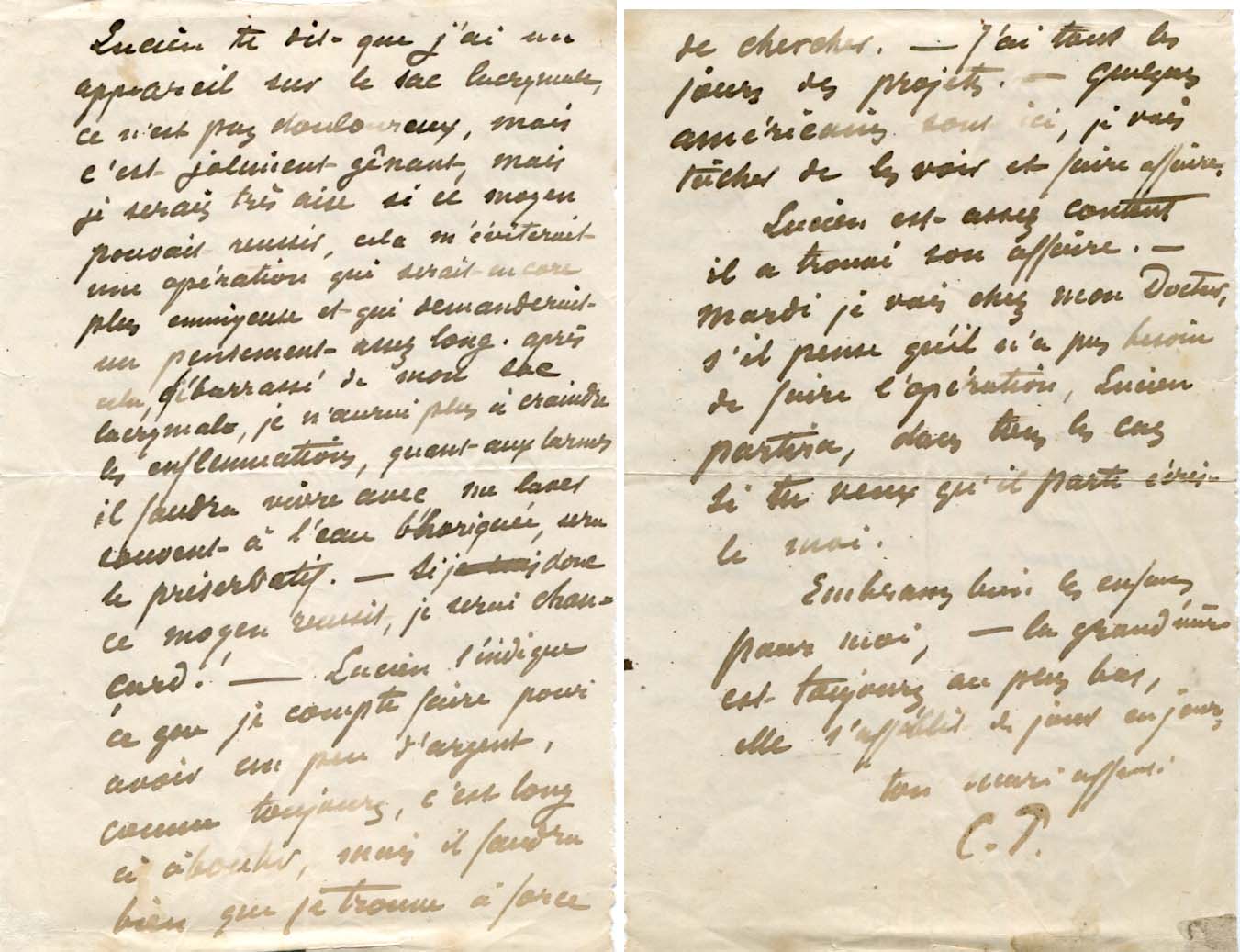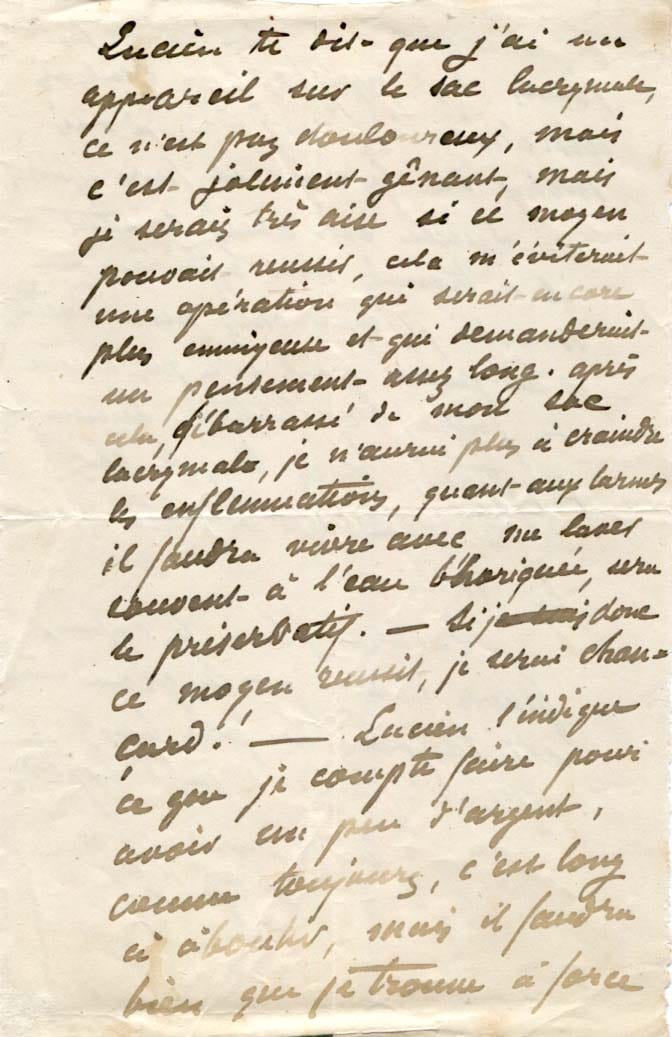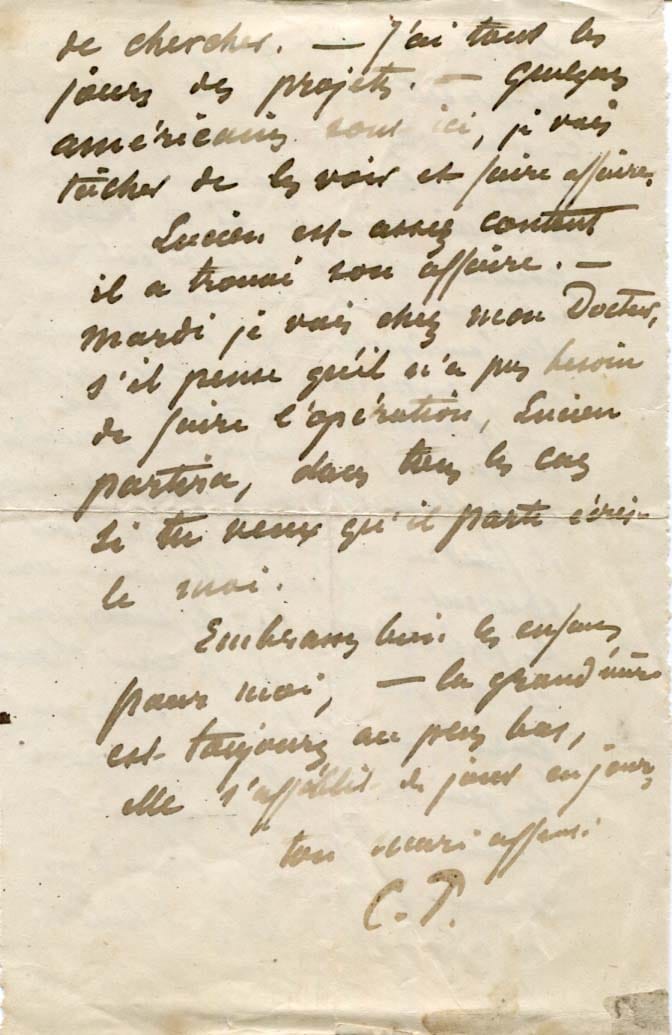Descripción
Autograph letter signed, two pages (both sides), 4,5 x 7 inch, undated (circa 1888-1889), in French, to his wife Julie Pissarro - concerning his eye problems and projects, written and signed in black ink "C. P.", with light intersecting letter folds and mild signs of wear to the edges - in fine condition.
In parts:
"Lucien te dit que j'ai un appareil sur le sac lacrymal, ce n'est pas douloureux, mais c'est joliment gênant, mais je serais très aise si ce moyen pouvait réussir, cela m'éviterait une opération qui serait encore plus ennuyeuse et qui demanderait un pansement assez long. Après cela, débarrassé de mon sac lacrymal, je n`aurai plus à craindre les inflammations, quant aux larmes il faudra vivre avec me laver souvent à l`eau bhorique, sera le préservatif. - Si ce moyen réussit, je serai chancard ! Lucien t'indique ce que je compte faire pour avoir un peu d'argent, comme toujours, c'est long à aboutir, mais il faudra bien que je trouve à force de chercher. - J'ai tous les jours des projets. - Quelques Américains sont ici, je vais tâcher de les voir et faire affaire [...]. Embrasse bien les enfants pour moi; - la grand-mère est toujours au plus bas, elle s'affaiblit de jour en jour [...]"
Translated:
"Lucien tells you that I have a device on the lacrimal sac, it's not painful, but it's pretty annoying, but I would be very comfortable if this method could succeed, it would save me an operation which would be even more tedious and which would require a rather long dressing. After that, rid of my lacrimal sac, I will no longer have to fear inflammation, as for tears, I will have to live with washing myself often with boric water, will be the preservative. - If this method succeeds, I will be lucky! Lucien tells you what I intend to do to get a little money, as always, it takes a long time to achieve, but I will have to find it by dint of looking. - I have projects every day. - A few Americans are here, I will try to see them and do business [...]. Kiss the children well for me; - the grandmother is still at her lowest, she is getting weaker day by day [...]"
From 1888 until his death in 1903, Camille Pissarro suffered from eye problems (dacryocystitis). He was treated by Dr. Parenteau. As he explains in this moving letter, Pissarro has tried wearing a pillow that compresses the lacrimal sac - with more or less success. He had to constantly wash his eye and carry a bandage. These compulsions compelled him especially to paint landscapes that can be observed from the window of his studio or from the window of a hotel. This led him from 1892 to produce cityscapes in Paris so that he could consult his ophthalmologist at any time. He moved to six different apartments to change perspectives and began painting from the top floors of the buildings. The result was the last series of his cityscapes - this one were the culmination of his work.
Más información sobre la persona
Profession:
(1830-1903) Danish-French Impressionist and Neo-Impressionist painter born on the island of St Thomas (now in the US Virgin Islands, but then in the Danish West Indies).
Year of Birth: 1830
Camille Pissarro was a French Impressionist painter born on July 10, 1830 in Charlotte Amalie, on the island of St. Thomas in the Danish West Indies. He was the oldest of seven children and his father was a Jewish merchant. Camille was exposed to art at a young age in the form of old master prints and books on art, and soon began to paint.
At the age of 12, Pissarro moved to Paris with his father and attended the Lycée Condorcet, where he studied drawing and painting. He also worked in a Parisian art gallery, studying the works of the Old Masters. After completing his studies, he returned to St. Thomas and worked as a clerk in his father’s business.
In 1855, Pissarro met Paul Cézanne and the two became friends. He was also exposed to the work of other Impressionists, such as Claude Monet and Edgar Degas. In 1859, he returned to Paris and began to develop his own style of painting. He used a combination of dark colors and bright colors to create a sense of movement and light in his paintings.
In 1863, Pissarro moved to Pontoise, just outside of Paris, and began to paint in the open air. This was the start of what became known as the Impressionist style of painting. His works from this period are characterized by a focus on light and color, and a loose brushwork. He also painted scenes of everyday life in the countryside.
In 1874, Pissarro joined the first Impressionist exhibition and became one of the leading figures in the movement. He helped to organize the exhibitions and wrote several essays on the importance of Impressionism. He was one of the few Impressionists to remain loyal to the movement throughout his career.
Pissarro continued to paint until his death in 1903. He is remembered as one of the leading figures of the Impressionist movement, and his works can be found in many of the world’s leading art galleries. His art is characterized by a vibrant and dynamic use of color, light, and texture, and his influence on modern art can still be seen today.
Certificado de autenticidad
Todas nuestras piezas se venden con un certificado de autenticidad. Si una pieza resulta estar equivocada o si no le gusta un autógrafo, recuperará su dinero durante toda la vida.
Pago y seguridad
Su información de pago se procesa de forma segura. No almacenamos los detalles de la tarjeta de crédito ni tenemos acceso a la información de su tarjeta de crédito.



